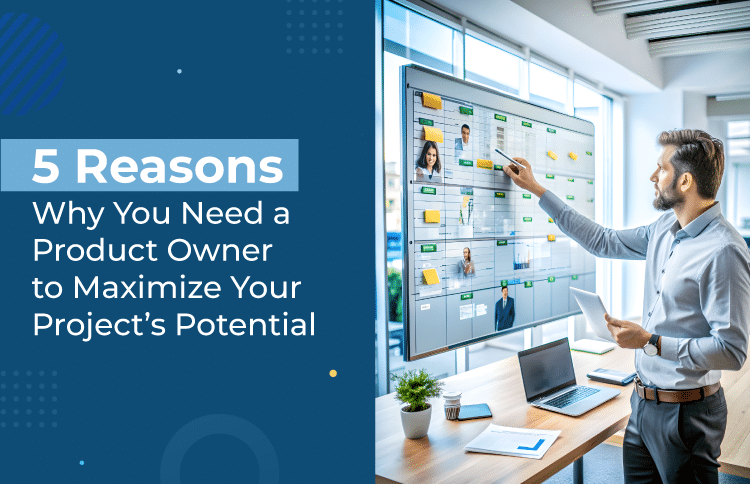5 Reasons Why You Need a Product Owner to Maximize Your Project’s Potential
Table of Contents
In today’s dynamic and competitive market landscape, transforming a vision into a successful product requires more than just a robust development process. It involves strategic oversight, meticulous planning, and effective management throughout the project lifecycle. A Product Owner (PO) is instrumental in navigating these complexities. By overseeing crucial aspects of the project, a PO ensures that your vision is realized, challenges are managed effectively, and your product achieves its full potential. Here are five compelling reasons why having a Product Owner can make all the difference.
1. Visionary Leadership
As a project founder or creator, your vision is likely expansive, encompassing a broad range of features, user experiences, and market goals. Translating this vision into actionable tasks and ensuring that it is clearly communicated across various teams can be challenging. This is where a Product Owner shines.
A PO serves as the custodian of your vision, ensuring that it is translated into clear, actionable directives for the development team. They act as a liaison between your strategic goals and the technical execution, ensuring that every team member understands and works towards the same objectives.
Example: Consider a tech startup developing a new AI-powered health app. The founder envisions a product that not only offers personalized health recommendations but also integrates seamlessly with wearable devices. The PO takes this vision and breaks it down into specific features, user stories, and tasks, such as integrating with APIs from different wearables, ensuring data privacy, and designing an intuitive user interface. They then communicate these requirements to the development, design, and marketing teams, aligning everyone toward the common goal.
Effective visionary leadership by a Product Owner involves not just translating your vision but also adapting it as market conditions and user needs evolve. The PO continuously assesses the project’s direction and makes adjustments to ensure that the product remains relevant and competitive.
2. Effective Stakeholder Management
Managing a project involves engaging with various stakeholders, each with their own expectations and interests. From initial planning and design to development, testing, and deployment, a Product Owner plays a crucial role in managing these relationships.
A skilled PO ensures that the project progresses smoothly, stays within budget, and meets timelines. They handle communication with stakeholders, address their concerns, and manage their expectations throughout the project lifecycle.
Example: In the development of a new enterprise software solution, the PO must coordinate with stakeholders from multiple departments, including sales, customer support, and IT. Each department has unique needs and priorities, such as CRM integration for the sales team, robust support features for customer service, and secure data handling for IT. The PO manages these diverse requirements, prioritizes them based on strategic goals, and ensures that the final product addresses the needs of all stakeholders.
Effective stakeholder management also involves conflict resolution and negotiation. A PO must navigate differing opinions and priorities, finding a balance that aligns with the project’s objectives while maintaining positive relationships with stakeholders.
3. Informed Decision Making
The development process is filled with critical decisions that can impact the project’s success. From prioritizing features and resolving conflicts to seizing strategic opportunities, the Product Owner provides valuable insights and guidance to navigate these challenges.
The PO’s experience and expertise are crucial in making well-informed decisions that align with the project’s goals. They analyze data, assess risks, and provide recommendations based on a deep understanding of both the product and the market.
Example: During the development of a new consumer app, the team faces a dilemma between adding a highly requested feature or addressing a critical security vulnerability. The PO evaluates the potential impact of both options, considers user feedback, and assesses the risks involved. They make a recommendation to prioritize the security update to ensure user trust and long-term success, while planning for the feature enhancement in the next release.
Informed decision-making by a PO also involves leveraging data and analytics. The PO uses insights from user behaviour, market trends, and competitive analysis to guide decisions and ensure that the product remains aligned with user needs and market opportunities.
You May Also Read: Mastering the Art of Data Storytelling: A Complete Guide
4. Strategic Product Backlog Management
A well-managed product backlog is essential for delivering incremental value and maintaining project focus. While you may handle prioritizing major features, the PO manages the broader backlog, ensuring that it remains organized and actionable.
The PO curates and refines the backlog by incorporating user feedback, market trends, and strategic priorities. They prioritize tasks, manage dependencies, and ensure that the development team delivers features that provide the most value.
Example: In an agile development environment for a SaaS platform, the PO manages a backlog that includes feature requests, bug fixes, and technical improvements. They regularly review and update the backlog based on feedback from beta users, emerging industry trends, and strategic goals. For instance, if user feedback highlights a need for improved onboarding, the PO might prioritize enhancements to the onboarding process while scheduling other features for future sprints.
Strategic backlog management also involves anticipating future needs and preparing for them. The PO works with the development team to identify potential risks and dependencies, ensuring that the backlog is aligned with the long-term vision and roadmap of the product.
5. Rigorous User Acceptance Testing
User Acceptance Testing (UAT) is a critical phase where the product is evaluated against the original vision and requirements. Having the Product Owner as the first user of the product ensures that any issues are identified and addressed before the product reaches end-users.
The PO’s deep understanding of the project’s goals and requirements allows them to effectively test the product, identify discrepancies, and ensure that it meets the intended objectives. Their involvement in UAT helps in delivering a high-quality product that aligns with user expectations.
Example: Before launching a new e-commerce website, the PO conducts UAT to verify that all features, such as product search, checkout, and payment processing, function as expected. They test various scenarios, including different payment methods and user interactions, to identify and resolve any issues. By doing so, they ensure that the website provides a seamless and satisfying experience for end-users.
Rigorous UAT also involves gathering feedback from real users and making final adjustments. The PO works closely with beta testers to gather insights, address any usability issues, and ensure that the product is ready for a successful launch.
You May Also Read: Agile and Scrum for Sustainable Delivery
Conclusion
In summary, a Product Owner plays a crucial role in transforming your vision into a successful product. From providing visionary leadership and managing stakeholders to making informed decisions, managing the product backlog, and overseeing user acceptance testing, the PO’s role is pivotal.
Investing in a Product Owner not only ensures that your project is managed efficiently but also maximizes its potential. In a competitive market, having a PO is not just beneficial but essential for staying ahead and achieving your project’s full potential. By leveraging their expertise and strategic oversight, you can focus on your end goals and drive your project towards success.
With the support of a Product Owner, you can navigate the complexities of product development with confidence, ensuring that your vision is realized and your project achieves its desired outcomes.

















